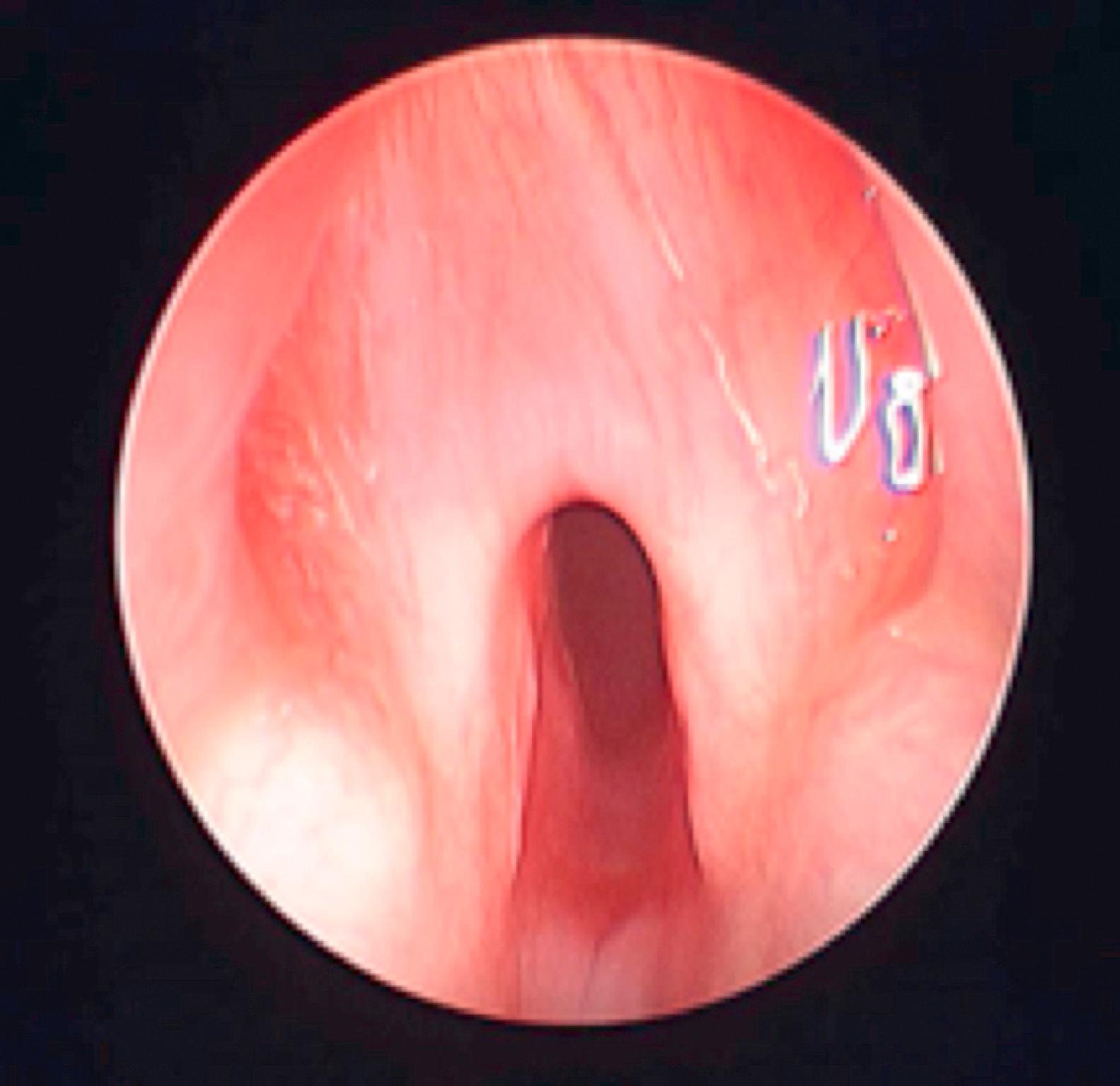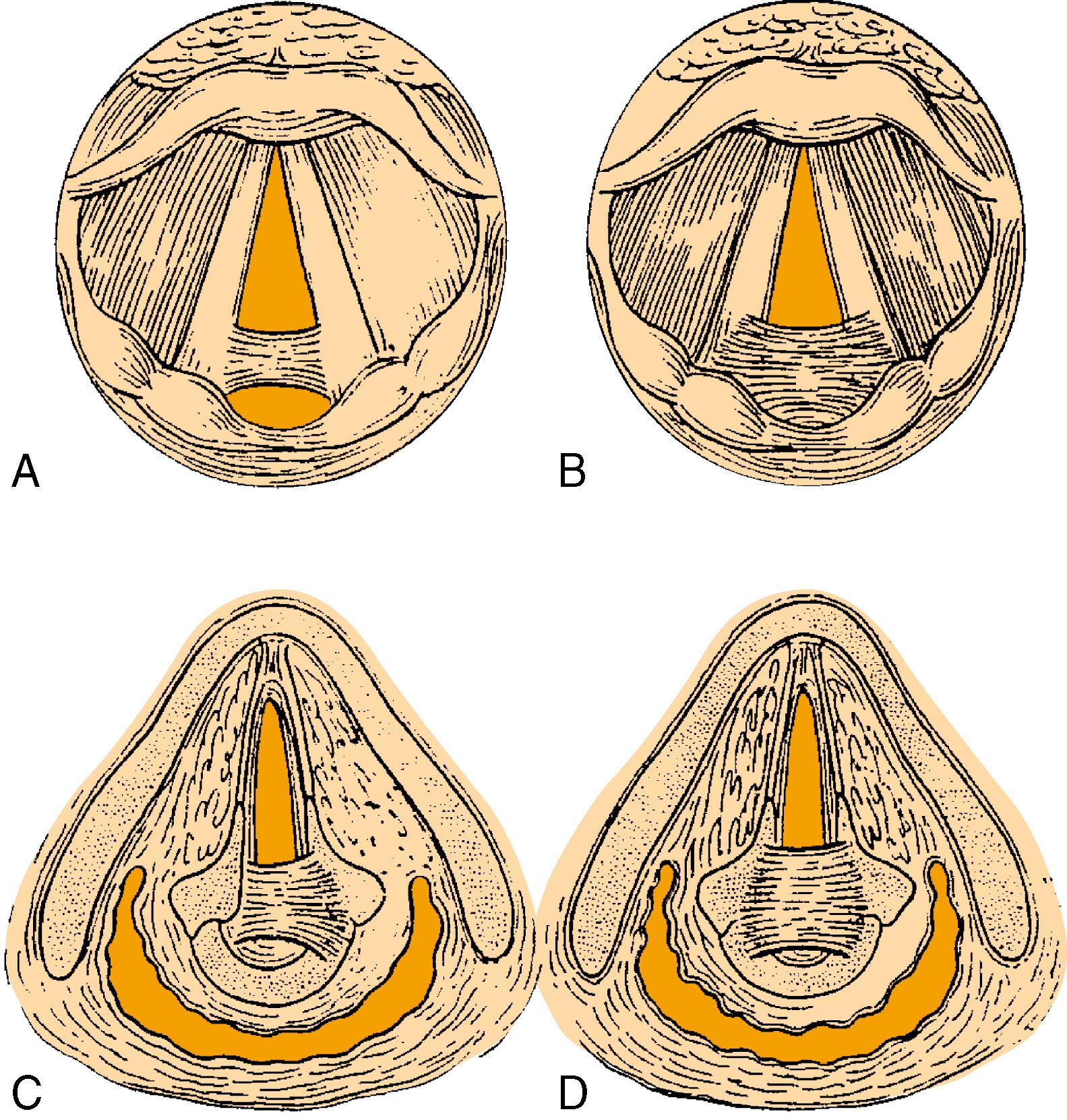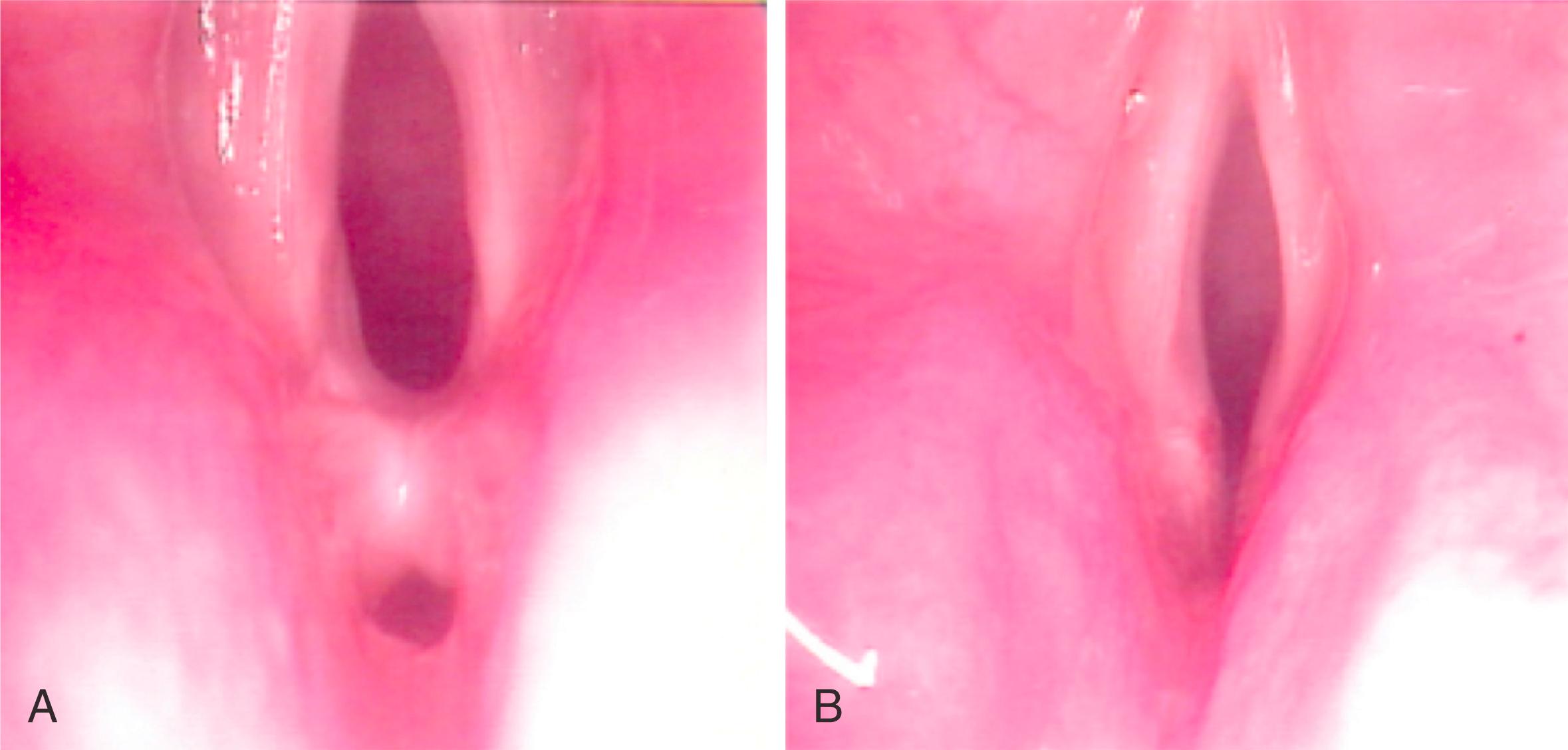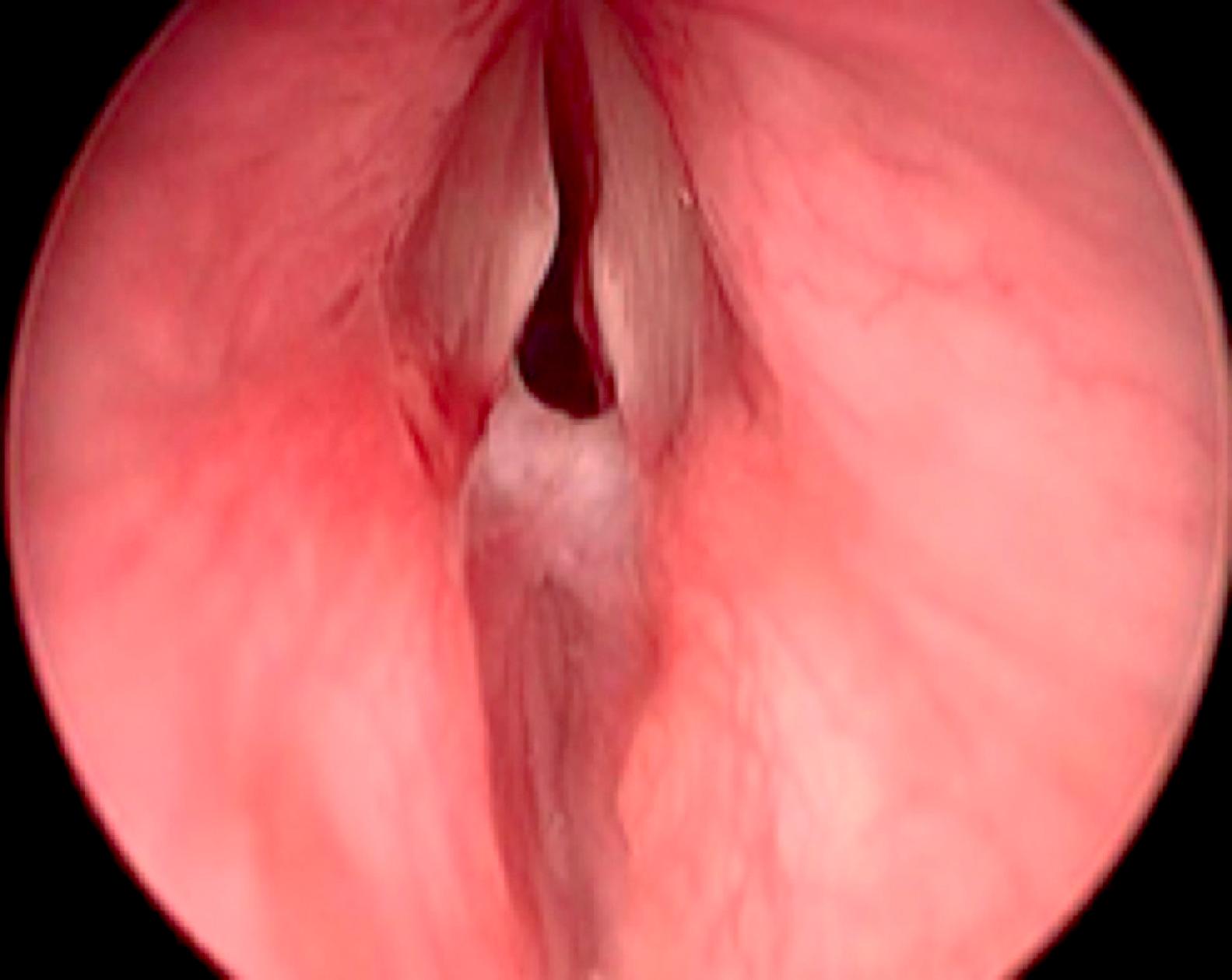Physical Address
304 North Cardinal St.
Dorchester Center, MA 02124
Laryngeal stenosis can be congenital or acquired. It often involves multiple levels of the airway. The presentation may range from mild symptoms affecting the voice, respiration, and/or feeding to significant respiratory distress requiring emergent intubation or tracheotomy to secure the airway.
Subglottic stenosis is the third most common congenital anomaly of the larynx, after laryngomalacia and true vocal fold immobility.
Acquired laryngeal stenosis can result from external or internal (iatrogenic) laryngeal trauma, chronic infection, caustic exposures, inflammatory diseases, reflux, or neoplasms.
The diagnosis of laryngeal stenosis is made by a thorough history and physical examination, flexible laryngoscopy, and careful examination of the airway (including palpation of the cricoarytenoid joint) during direct laryngotracheobronchoscopy. Adjuncts such as preoperative radiographic imaging, esophagoscopy and feeding evaluations, pulmonary function tests, and voice evaluations can be helpful.
The multidisciplinary team caring for patients with laryngeal stenosis includes otolaryngologists, speech and language pathologists, gastroenterologists, pulmonologists, general surgeons, and anesthesiologists. Other services, including cardiology and thoracic surgery, should be consulted on a case-by-case basis.
Mild stenosis can be managed with close observation and symptomatic treatment of upper respiratory infections.
Management of moderate to severe stenosis can be challenging. Thus it is critical to strive to prevent airway scarring by using appropriately sized endotracheal tubes (ETTs), avoiding prolonged intubation, treating reflux, and taking care when the airway is being instrumented.
In the past 10-15 years, management has trended toward endoscopic approaches for laryngeal stenosis. Endoscopic techniques are associated with lower patient morbidity but may require multiple procedures to obtain a satisfactory result.
Open procedures consist of expansion and resection surgeries, with stenting and grafting as necessary. In a single-stage procedure, the patient can be decannulated intraoperatively. In a double-stage procedure, the patient is decannulated at a later date.
The choice of procedure should be dictated by the patient’s individual pathology and overall condition, the resources available, and the surgeon’s expertise.
Laryngeal stenosis is a rare but life-threatening condition in the pediatric population. The subglottis is the most common area of involvement. Stenosis may be congenital or acquired. Congenital etiologies are commonly associated with other anomalies or syndromes. Acquired stenosis most often results from accidental or iatrogenic trauma to the airway. Historically, glottic and subglottic stenoses were managed with open laryngotracheal reconstruction (LTR). In the past 10-15 years, management has trended toward the use of endoscopic techniques, which are less invasive and carry lower morbidity. Open LTR is used for the more severe and recalcitrant presentations.
The epithelial lining of the larynx develops from the endoderm of the cranial end of the laryngotracheal tube. The laryngeal cartilages, specifically the thyroid, cricoid, paired arytenoid, paired corniculate, and paired cuneiform, develop from the fourth and sixth paired pharyngeal arches. The laryngeal musculature also develops from the fourth (cricothyroid) and sixth (intrinsic laryngeal muscles) pharyngeal arches, resulting in innervation by the superior laryngeal nerve and the recurrent laryngeal nerve of the vagus nerve, respectively. The epiglottis is formed from mesenchyme from the ventral ends of the third and fourth pharyngeal arches, known as the hypopharyngeal eminence, which also forms the base of the tongue. ,
Between the fourth and tenth weeks of fetal development, the mesenchyme at the cranial end of the laryngotracheal tube proliferates and forms bilateral arytenoid swellings. The swellings grow toward the tongue and convert the sagittal slitlike primordial glottis into a T-shaped laryngeal inlet. The epithelium undergoes rapid proliferation and temporarily occludes the laryngeal lumen. Vacuolization and recanalization occurs by the 10th week, producing the paired laryngeal ventricles, precursors to the false and true vocal folds, and a patent laryngeal inlet.
Congenital high airway obstruction syndrome (CHAOS) is a rare condition resulting from complete failure of recanalization. The obstruction is most often at the level of the larynx (laryngeal atresia), although subglottic and tracheal atresia may occur. CHAOS is associated with large echogenic lungs, a flattened or inverted diaphragm, dilated airways distal to the obstruction, and fetal ascites and/or hydrops. , Neonates present at birth with aphonia, extreme respiratory distress, cyanosis, and rapid respiratory decompensation. Endotracheal intubation is usually impossible unless a thin stenosis can be punctured. In the past, this condition was universally fatal unless the patient had an associated tracheo- or bronchoesophageal fistula. Advances in prenatal ultrasound and magnetic resonance imaging (MRI) have enabled detection of the obstruction prior to birth, allowing for prenatal planning, which has led to increased survival through management of the infant airway using ex utero intrapartum treatment (EXIT) and tracheotomy (see Chapter 27).
Incomplete recanalization of the embryologic larynx results in congenital laryngeal stenosis and webbing. , Congenital laryngeal webs ( Fig. 28.1 ) account for 5% of congenital anomalies of the larynx. About 75% of webs occur at the glottic level and the remainder involve the supraglottis or subglottis. Glottic webs are usually anterior, presenting as abnormal voice, stridor, or respiratory distress. Most webs present at birth or in the first few months of life. Some anterior webs are gossamer thin and may go undiagnosed for years. Others are thicker and extend into the subglottis, compromising the subglottic lumen. Cohen proposed a grading scale as follows: type 1 consists of a thin anterior web with less than 35% glottic involvement that may be asymptomatic or associated with hoarseness; type 2 describes 35% to 50% glottic involvement causing mild airway symptoms and a weak cry; type 3 is a web involving 50% to 75% of the glottis and is commonly associated with subglottic stenosis (SGS), causing dyspnea and hoarse voice; type 4 is a glottic web up to 75% to 99% with associated SGS, leading to severe airway symptoms at birth and aphonia. There is an association between anterior glottic webs and chromosome 22q11.2 deletion (velocardiofacial syndrome). Children with laryngeal webs should undergo a genetic workup for 22q11.2 deletion.

Bilateral true vocal fold immobility (BTVFI) accounts for 30% to 60% of laryngeal anomalies in children. Children with BTVFI present with biphasic stridor, respiratory distress, dysphagia, and/or voice changes and may be misdiagnosed with SGS. The etiology may be traumatic from delivery or surgery, neurologic, or idiopathic, with reported incidences of 40%, 40%, and 30%, respectively. Pediatric bilateral vocal fold immobility of any etiology has an estimated rate of spontaneous recovery between 52% and 65%. , , Thus any procedure performed to stabilize the airway should not have long-term effects on vocal function or swallowing. Historically, tracheotomy presented the best alternative, and it may still be required to treat acute respiratory distress.
The normal diameter of the subglottic lumen in the full-term neonate is between 4.5 and 5.5 mm; in premature babies, the diameter is about 3.5 mm. A subglottic diameter of 4 mm or less in a full-term neonate is considered to be narrowed. The cross-sectional area of a lumen is equal to πr, where r is the radius. Thus narrowing the tracheal lumen by 1 mm can significantly decrease the area for air passage. For example, the lumen is reduced by 40% when airway radius decreases from 4 to 3 mm.
SGS is considered congenital if the patient has no prior history of endotracheal intubation, surgery, trauma, or other possible etiology of acquired stenosis. Many infants that present at birth with respiratory distress are intubated by necessity prior to endoscopic airway evaluation. Thus by best approximation, congenital SGS is the third most common congenital disorder of the larynx, after laryngomalacia and vocal fold immobility, although congenital SGS make up only 5% of all SGS.
Congenital SGS can be divided into membranous and cartilaginous types. The membranous type is a fibrous soft tissue thickening of the subglottic area caused by increased fibrous connective tissue or hyperplastic dilated mucous glands without an inflammatory reaction. It is usually circumferential, with the narrowest area 2 to 3 mm below the true vocal cords (TVCs), and it sometimes extends upward to include the TVCs. The cartilaginous types are more variable. The most common type is a thickening or deformity of the cricoid cartilage that causes a shelflike plate of cartilage partially filling the concave inner surface of the cricoid ring and extending posteriorly as a solid rigid sheet, leaving only a small posterior opening. An elliptical cricoid cartilage, sometimes seen in patients with trisomy 21, is another type of cartilaginous congenital subglottic narrowing.
Symptoms depend on the degree of subglottic narrowing. In severe cases, respiratory distress and stridor are present at birth; in milder cases, upper respiratory infections may precipitate further swelling in the already narrow airway, causing infants to present during the first few weeks or months of life with prolonged or recurrent croup. The child may be well between episodes of increased work of breathing, stridor, and barking cough. Infants usually become symptomatic within 3 months of birth because of increased activity and greater ventilation requirements. , In a large series of patients with congenital SGS, less than half required tracheotomy. The differential diagnosis (see Chapter 27) includes subglottic hemangioma, subglottic cysts, and distinct episodes of recurrent croup without anatomic abnormality.
External trauma to the airway is an uncommon cause of acquired laryngeal stenosis and may result in stenosis at the level of the supraglottis, glottis, subglottis, or multiple levels. Laryngeal fracture typically results from blunt trauma to the neck during motor vehicle accidents or sports injuries. Stenosis caused by external trauma is more common in adults than in children, who are protected by a prominent mandible and relatively high position of the larynx. In children, external laryngeal trauma occurs when the neck is struck during falls, sports injuries, and nonaccidental injuries. , Chronic acquired laryngeal stenosis is often a sequela of severe laryngeal trauma with fracture of the cricoid and thyroid cartilages, with or without displacement, or caused by iatrogenic injury during management of trauma.
The “clothesline injury” occurs when a person moving at speed, as on a bicycle or all-terrain vehicle, hits his or her anterior neck on a fixed, thin horizontal object such as a branch or clothesline. Laryngeal fracture or thyrotracheal or cricotracheal separation may result, which is not uniformly fatal. Penetrating neck trauma can also injure the airway and cause scarring.
Approximately 90% of cases of acquired chronic SGS in infants and children occur secondary to endotracheal intubation. , The areas most commonly injured are the subglottic region in children and the posterior glottis in adults. The incidence of acquired SGS in premature infants was as high as 8% in the 1970s but currently is reported to be between 1% and 2%. The decrease is likely caused by recognition of prolonged intubation as the cause of SGS, refinement in the management techniques used in neonatal intensive care units (NICUs), and implementation of preventive measures. , These figures may underestimate the true incidence of the disease in the pediatric population, as some infants requiring prolonged intubation do not survive the primary illness. In addition, some cases of acquired SGS may remain subclinical and unrecognized until an infection of the upper respiratory tract develops or the patient requires intubation later in life.
In children, the subglottic region is especially prone to injury from endotracheal intubation for multiple reasons. First, the cricoid cartilage is the only area in the upper airway that has a complete cartilaginous ring; it represents the narrowest point in the airway. Second, the pseudostratified, ciliated, columnar respiratory epithelium lining in this region is delicate and tends to deteriorate under the stress of an indwelling tube. Third, the subglottic submucosa is made up of loose areolar tissue that allows edema to develop easily and quickly.
The pathophysiology of acquired SGS is well described in the literature. , Wound healing at any location in the body occurs in three phases: (1) inflammation, (2) proliferation, and (3) maturation. Acquired SGS is a result of abnormal wound-healing processes leading to “hypertrophic” scar formation and narrowing of the airway lumen. The endotracheal tube (ETT) causes pressure necrosis at the point of interface with tissue, which leads to mucosal edema and ulceration. As ulceration deepens, normal ciliary flow is interrupted, with mucociliary stasis leading to secondary infection and perichondritis. With further infection, chondritis and cartilaginous necrosis occur. Healing occurs by secondary intention, with granulation tissue proliferation in the areas of ulceration and the deposition of fibrous tissue in the submucosa. Primary healing of the laryngeal injury is hindered by the presence of loose and mobile subglottic mucosa, poor blood supply to the cartilage, and constant motion of the larynx associated with swallowing and head movement. , Unlike other types of surgery, in which the restoration of the “normal” anatomic architecture is the desired outcome, treatment of SGS must avoid both the physiologic and the pathophysiologic healing processes that lead to scar formation. Because appropriate wound healing is the source of the problem, researchers have tried to modulate this process and suppress the fibrotic reaction leading to SGS.
A study of intubated larynges from human infants of 22 to 40 weeks of gestation who survived for a few hours to 300 days showed that acute injury was almost invariable. Up to 100% of the subglottic epithelium was lost within a few hours of intubation, but progression of injury was relatively short lived. Ulcer healing started after a few days, rapidly progressed from day 10, and, in most cases, was complete after 30 days. This study suggests that long-standing acute injury of the subglottis is the exception rather than the rule, even with the ETT remaining in place. What is poorly understood is why, under identical circumstances, some patients will form severe scar and others will have relatively normal-appearing larynges after intubation.
Factors that contribute to the development of acquired stenosis include the size of the ETT, movement of the ETT, duration of intubation, traumatic intubation, presence of an infection while intubated, and possibly gastroesophageal reflux disease (GERD). Repeated intubations cause increased trauma and increase the risk of sequelae. Education of physician and nursing personnel who care for intubated patients is critical, because the inexperience of personnel is associated with higher complication rates. Systemic factors including chronic illness, poor nutritional status, immunosuppression, anemia, neutropenia, sepsis dehydration, hypoxemia, poor perfusion, radiotherapy, exposure to cigarette smoking, and the presence of gastric acid reflux predispose the laryngeal mucosa to injury by decreasing tissue resistance and increasing infection rate.
Overwhelmingly, duration of intubation and the size of the ETT are the most important factors in the development of laryngeal stenosis. No definite safe time limit for endotracheal intubation has been established. Severe injury has been reported after 17 hours of intubation in adults and 1 week after intubation in neonates. , Premature infants tolerate a longer duration of intubation (weeks rather than days), possibly because of the high location of the neonatal larynx in the neck, with its posterior tilt and funnel shape, and the relative immaturity of the laryngeal cartilage in neonates. Because the laryngeal cartilage is more hypercellular with a scant gel-like matrix, it is more pliable and thus able to yield to pressure.
Insertion of an oversized ETT increases the risk of laryngeal injury. In children, the ideal tube size should allow an air leak at 20 cm water pressure. The appropriate ETT size can be estimated in children by the patient’s age ( Table 28.1 ) but should be confirmed by checking for a leak. Polymeric silicone and polyvinyl chloride are considered the safest materials for prolonged intubation. Microcuffed pediatric ETTs further decrease the surface area of the larynx exposed to pressure.
| Age | Endotracheal Tube | Tracheotomy | Bronchoscope |
|---|---|---|---|
| Premature | 2.5 | 2.5 | 2.5 |
| 0–6 months | 3 | 3 | 3 |
| 6–12 months | 3.5 | 3.5 | 3.5 |
| 1–2 years | 4 | 4 | 3.7 |
| 2–3 years | 4.5 | 4.5 | 4 |
| 3–4 years | 4.5 | 5 | 4.5 |
| 4–5 years | 5 | 5.5 | 5 |
SGS may occur secondary to airway injury resulting from airway surgery. Emergency cricothyroidotomy through the cricothyroid membrane and high tracheotomy can produce severe stenosis, particularly in children. Methods designed to treat laryngeal stenosis, including endoscopic approaches, open LTR, and cricotracheal resection (CTR) can all result in further scarring and stenosis of the airway.
GERD and gastrolaryngopharyngeal reflux disease (GLPRD) have been shown to be more common in patients with laryngeal stenosis than in the general population. Some authors assert that GERD may play a role in the development and exacerbation of SGS and may adversely affect the successful outcome of surgical repairs (see Chapter 35).
Chondroma, fibroma, hemangioma, and carcinoma can cause SGS because of tumor infiltration or secondary to infective perichondritis, postradiation perichondritis, or postsurgical scarring and stenosis.
Acquired anterior glottic stenosis most commonly results from endoscopic laryngeal surgery with cold steel, electrocautery, or laser. , When surgery involves the anterior aspect of both true vocal folds, the two opposing mucosal surfaces may heal together and form a scar band. Acquired complete glottic stenosis rarely occurs in isolation and is usually accompanied by supraglottic stenosis or SGS. In children, it is a sequel of endotracheal intubation, lye ingestion, or thermal burn.
Posterior glottic stenosis (PGS) is most commonly caused by prolonged intubation. Pressure necrosis of the mucosa that overlies the vocal process of the arytenoid is followed by ulceration and the formation of granulation tissue on the medial surface of the body of the arytenoid cartilage. Scar forms in the interarytenoid space and can limit mobility of one or both cricoarytenoid joints, narrowing the laryngeal inlet. Bogdasarian described four grades ( Figs. 28.2 to 28.4 ). However, it is difficult to differentiate grade II, III, and IV scarring on a clinical basis. Children with Down syndrome have a higher rate of PGS than the general population. Electromyographic studies may be useful to differentiate PGS from vocal fold immobility in the adducted position. However, the diagnosis is best made by clinical history and physical examination, including direct laryngoscopy with palpation of the interarytenoid space and cricoarytenoid joints.



It is important to differentiate between a complete PGS and an interarytenoid adhesion, as the prognoses for these two lesions differ. In complete PGS, the scar is located in the interarytenoid space and posterior commissure, whereas for interarytenoid adhesion, the scar occurs between the vocal processes of the arytenoids with a small posterior mucosally lined sinus tract in the area of the posterior commissure. Scarring of the posterior commissure may be confined to the submucosa or may extend into one or both of the cricoarytenoid joints.
The primary symptoms of PGS relate to narrowing of the airway. In mild or moderate cases the patient may be able to ventilate without a tracheotomy and may experience only exercise intolerance. Patients who have a more severe stenosis may need a tracheotomy for adequate respiration. Voice complaints are usually minimal, as PGS causes adduction of the true vocal folds.
Become a Clinical Tree membership for Full access and enjoy Unlimited articles
If you are a member. Log in here